Warplanes of Germany: Luftwaffe aircraft preserved in the UK
German War Prize aircraft in the UK
The aim of this website is to locate, identify and document Warplanes from the Second World War preserved in the United Kingdom. Many contributors have assisted in the hunt for these aircraft to provide and update the data on this website. Photos are by the author unless otherwise credited. Any errors found here are by the author, and any additions, corrections or amendments to this list of Warplane Survivors of the Second World War in the United Kingdom would be most welcome and may be e-mailed to the author at [email protected].
German Warplanes of the Second World War preserved in the United Kingdom by aircraft type, serial number, registration number and location:

(ozz13X Photo)

(Graham Bould Photo)
Bücker Bü 181E Bestmann, Reg, No. G-GLSU, built in 1940, The Shuttleworth Collection, Old Warden, Bedfordshire.

(Bundesarchiv Bild 101I-341-0489-10A)
Dornier Do 17Z.

(Dapi89 Photo)

(Flightsoffancy Photo)
Dornier Do 17Z-2 (Wk. Nr. 1160), wreckage recently recovered.

(Happy Days Photo)
Dornier Do 24T-3, (Wk. Nr. No. 5342), X-24, formerly EC-DAF, is on loan to the Militaire Luchtvaart Museum in the Netherlands from the Royal Air Force Museum London, Hendon.

(Alec Wilson Photo)
Fieseler Fi 156A-1 Storch (Wk. Nr. 2088), GM+AI, Reg. No. G-STCH, built in 1943, Peter Holloway, The Shuttleworth Collection, Old Warden, Bedfordshire.


(Rept0n1x Photos)

(Tony Hisgett Photo)

(Desmoh Photo)

(Alan Wilson Photo)
Fieseler Fi 156C-7 Storch (Wk. Nr. 475081), CF+HF, Re. No. EI-AUY, Royal Air Force Museum Cosford, Shifnal, Shropshire.
Morane-Saulnier MS.505 Criquet (Storch), TA+RC, Reg. No. G-BPHZ, Historic Aircraft Collection, Duxford, Cambridgeshire. Airworthy.

(Mike Freer - Touchdown-aviation Photo)
Morane-Saulnier MS.505 Criquet (Storch), FI+S, Reg. No. G-BIRW, National Museum of Flight, East Fortune, Scotland.

(ECM Photo)
Fieseler Fi 103, V-1, FZG 76 flying bomb, Eden Camp Museum, Malton.
The V-1 flying bomb Vergeltungswaffe 1 (Vengeance Weapon 1), also known to the Allies as the buzz bomb, or doodlebug, and in Germany as Kirschkern (cherrystone) or Maikäfer (maybug), was an early cruise missile and the only production aircraft to use a pulsejet for power.
The V-1 was the first of the so-called "Vengeance weapons" (V-weapons or Vergeltungswaffen) series designed for the terror bombing of London. It was developed at the Peenemünde Army Army Research Center in 1939 by the German Luftwaffe during the Second World War. During initial development it was known by the codename "Cherry Stone". Because of its limited range, the thousands of V-1 missiles launched into England were fired from launch facilities along the French (Pas-de-Calais) and Dutch coasts. The first V-1 was launched at London on 13 June 1944, one week after (and prompted by) the successful Allied D-Day landings in Europe. At its peak, more than one hundred V-1s a day were fired at south-east England, 9,521 in total, decreasing in number as sites were overrun until October 1944, when the last V-1 site in range of Britain was overrun by Allied forces. After this, the V-1s were directed at the port of Antwerp and other targets in Belgium, with 2,448 V-1s being launched. The attacks stopped only a month before the war in Europe ended, when the last launch site in the Low Countries was overrun on 29 March 1945.
The British operated an arrangement of air defences, including anti-aircraft guns and fighter aircraft, to intercept the bombs before they reached their targets as part of Operation Crossbow, while the launch sites and underground V-1 storage depots were targets of strategic bombing. (Wikipedia)
Fieseler Fi 103, V-1, FZG 76 flying bomb, (Wk. Nr. 442795), Science Museum, London. It was presented to the museum in 1945 by the War Office.

(Florestan Photo)
Fieseler Fi 103, V-1, FZG 76 flying bomb, on display in the Imperial War Museum, London.

(Martin Richards Photo)
Fieseler Fi 103, V-1, FZG 76 flying bomb, mounted on a partial ramp section, at the Imperial War Museum Duxford. The museum also has a partially recreated launch ramp with a mock–up V-1 displayed outside.

(Goshimini Photo)
Fieseler Fi 103 V-1, FZG 76 flying bomb, (Wk. Nr. 418947), on display in front of a V2 rocket in the Royal Air Force Museum Cosford, Shifnal, Shropshire.
Fieseler Fi 103 V-1, FZG 76 flying bomb, on display at the Aeropark at East Midlands Airport.

(Bundesarchiv, Bild 141-2733)
US troops inspect Fieseler Fi 103R-4 at Neu Tramm, Germany, 1945.

(US Army Photo)
Fieseler Fi 103R-4, found in sheds at the V-bomb assembly plant, waiting for shipment to launching sites, 1945.
Fieseler Fi 103R Reichenberg IV piloted flying bomb (Wk. Nr. 6/2080), Lashenden Air Warfare Museum. This Fi 103R-4 is reported to have been captured at the Dannenburg V-1 factory by the US Army and transported to the UK in 1945. It was on display at the German aircraft exhibitioin at RAE Farnborough and later passed to the Joint Services Bomb Disposal School at Horsham, West Sussex, and then to the Territorial Bomb Disposal Unit at Fort Clarence in Rochester, Kent.

(Luftwaffe Photo)
Flettner Fi 282B Kolibri (Hummingbird), coded CJ+SN 20th prototype, Midland Air Museum. This German helicopter was used for trials, including shipboard development flying at Kiel's Holtenau airfield in northern Germany. It was captured at Travemunde in mid-1945 and moved to Britain by July, where it was issued to the College of Aeronautics at Cranfield on 1 Aug 1946. In cut-down form it was transferred to the Midland Air Museum in May 1975.
Focke-Achgelis Fa 330, Lashenden Air Warfare Museum.
Focke-Achgelis Fa 330, Fleet Air Arm Museum, RNAS Yeovilton, Somerset.

(MilborneOne Photo)


(Yachtman Photos)
Focke-Achgelis Fa 330A-1 (Wk. Nr. 100503), Royal Air Force Museum Cosford, Shifnal, Shropshire.

(Mark Harkin Photo)

(Clemens Vasters Photo)
Focke-Achgelis Fa 330, Imperial War Museum, Duxford.
Focke-Achgelis Fa 330, (Wk. Nr. 100502), RAF Millom Museum. This museum has closed, the Fa 330 has been moved to a location TBC.

(ozz13x Photo)
Focke-Wulf Fw 44 (Serial No. D-2692), The Shuttleworth Collection, Old Warden, Bedfordshire.
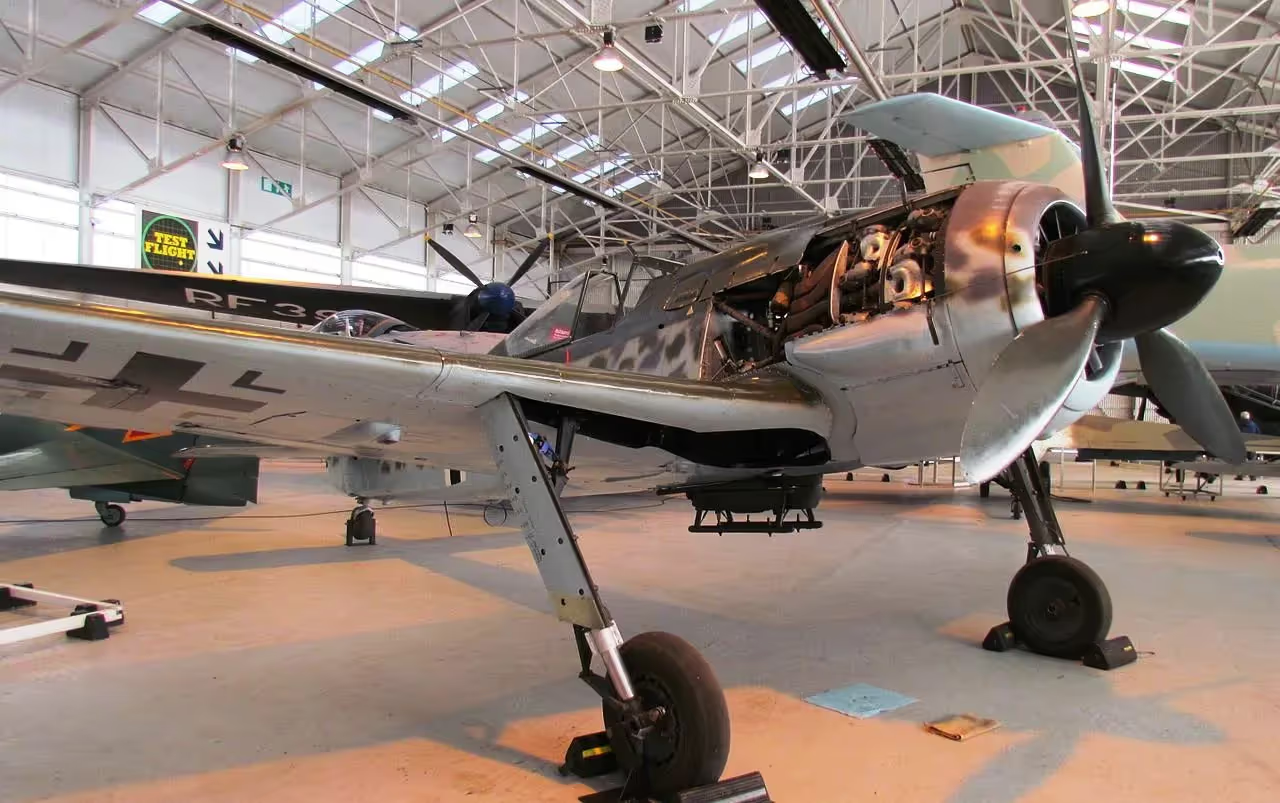

(ozz13x Photos)
Focke Wulf Fw 190A (newbuild), Royal Air Force Museum Cosford, Shifnal, Shropshire.
Focke-Wulf Fw 190A-8 (new-build), Reg. No. G-FWAB, Spitfire Ltd, Duxford, Cambridgeshire. Airworthy.
Focke-Wulf Fw 190D-9, (Wk. Nr. 211028), coded Black 8, 14/JG26 was preserved in England after being recovered from Germany in 1996. This aircraft was registered on 21 May 2003, by Glenn R. Lacey of Epsom, Surrey, as G-DORA. (Wk. Nr. 211028) is currently with the Fighter Factory at Virginia Beach, USA, as the Lacey collection no longer exists.


(RAF Photos)
Focke-Wulf Fw 190F-8/U1 (Fw 190S8) two-seat training and high speed transport (Wk. Nr. 584219), Black 38, RAF AM29. This aircraft was built by Arado at the Warnemünde factory, and was an FW 190 F-8 converted to two-seat standard. Captured in Grove, Denmark, North of Schleswig-Holstein, Germany by British forces in May 1945. It is shown here shortly after it was flown to Farnborough in the UK on 2 Sep 1945 and repainted with RAF markings. In Luftwaffe service, it operated with training units, and carried the letters HRZ. It was exhibited at various locations, and now resides in the Royal Air Force Museum Hendon, London.

(RuthAS Photo)

(Les Chatfield Photo)


(Alan Wilson Photos)
Focke-Wulf Fw 190F-8/U1 (Wk. Nr. 584219), two-seat training version, Black 38, designated RAF AM29, on display in the Royal Air Force Museum Hendon, London.

(RAF Photo)
Mistel S2, Focke-Wulf Fw 190A mounted on a Junkers Ju 88H1 (Wk. Nr. 714633), RAF, Schleswig, 1945.

(RAF Photo)
Mistel S3A, Focke-Wulf Fw 190A-8/R6, (Wk. Nr. 733759), designated RAF AM77 combined with Junkers Ju 88A, (Wk. Nr. 2492). Both are believed to have been scrapped at Farnborough.

(Zzztriple 2000 Photo)
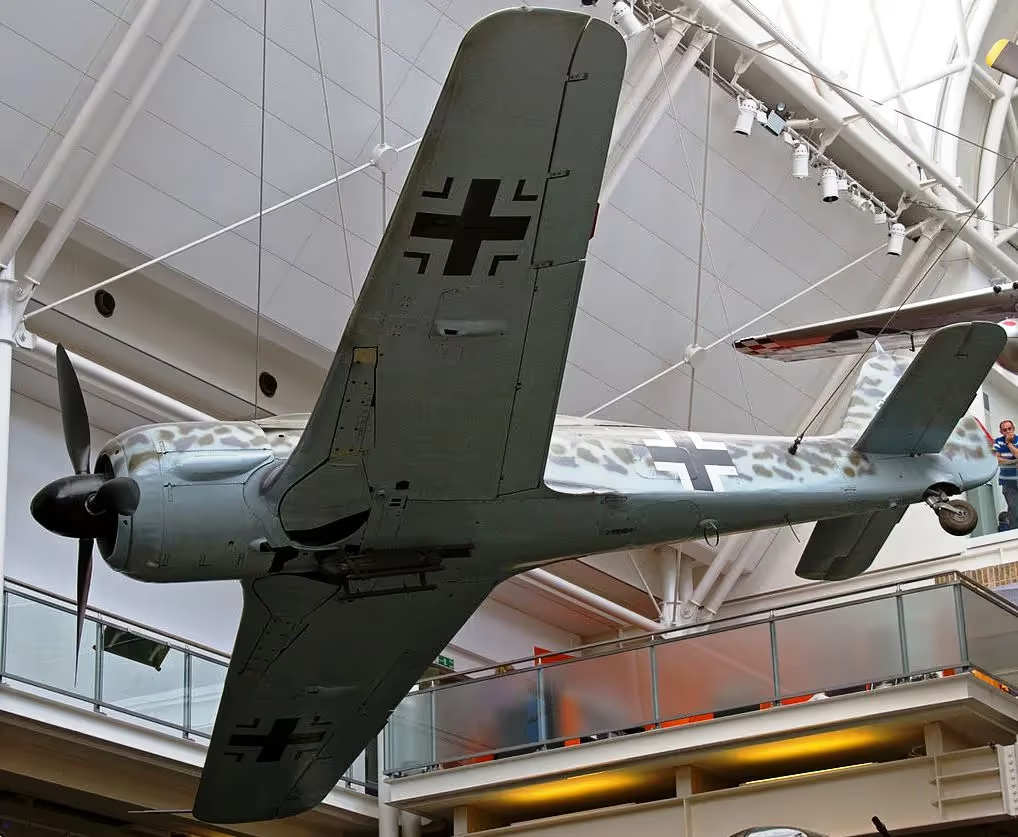
(Tony Hisgett Photo)


(Gustav Gullberg Photos)
Focke-Wulf Fw 190A-8/R6, (Wk. Nr. 733682), RAF AM75. This aircraft was captured at Tirstrup, Denmark where it was found mounted on top of a Junkers Ju 88A-6 bomber, (Wk. Nr. 2492), RAF AM77, as part of a Mistel S3B combination. This aircraft has faired-over gun ports and a belly-mounted ETC-501 bomb rack. This aircraft was on display in the Imperial War Museum, but is now with the Royal Air Force Museum Cosford, Shifnal, Shropshire. The Ju 88 was scrapped at Farnborough.

(Kogo Photo)

(Oxyman Photo)
Fritz X, German Second World War Air-to-Ship Wireless Guided Gliding Bomb, Royal Air Force Museum Hendon, London. The Fritz X was the world's first precision guided weapon ever deployed in combat, and the first to sink a ship in combat. Fritz X was a nickname used both by Allied and Luftwaffe personnel. Alternative names include Ruhrstahl SD 1400 X, Kramer X-1, PC 1400X or FX 1400 (the latter, along with the unguided PC 1400 ordnance's Fritz nickname, is the origin for the name "Fritz X").


(USAAF Photos)
Heinkel He 111H-20, (Wk. Nr. 701152), NT+SL in USAAF markings.
Heinkel He 111H-20, (Wk. Nr. 701152), NT+SL captured in the Munich area of Germany, shown here in USAAF markings. This aircraft was flown by Watsons Whizzers and then by the 56th FG, 8th USAAF before being handed over to the RAF. It was painted black and had an RAF roundel painted over the USAAF star and bar markings. The peculiar logo on the fuselage is the letter W inside a C inside an O from the initials of Major J. Carter of the 61st Fighter Squadron, Major Williamson of the 62nd FS and Captain Ordway, Engineer Officer of the 61stFS. This aircraft is preserved in the Royal Air Force Museum Hendon, London.

(Roland Turner Photo)

(Hugh Llewlyn Photo)


(Alan Wilson Photos)
Heinkel He 111H-20, (Wk. Nr. 701152), coded NT+SL. This aircraft was built in 1944 and modified to drop Fallschirmjäger (paratroops). It is on display in the Royal Air Force Museum Hendon, London.
Heinkel He 111H-16/CASA C-2111B (Serial No. B21-27), Battle of Britain Museum Trust. Acquired from the IWM, this aircraft will be restored to represent Heinkel He 111H-2 (Wk. Nr. 3140), coded A1+DA of Stab Kampfgeschwader 53, which was shot down on 15 Sp 1940 while on a bombing sortie over London.
CASA C-2111B (Serial No. B21-103), Imperial War Museum, Duxford, Cambridgeshire.

(Alan Wilson Photo)

(tataquax Photo)

(Panhard Photo)
Heinkel He 162A-2, (Wk. Nr. 120227) of JG 1, captured at Leck in northern Germany. Designated RAF AM65, later VN629 this aircraft was brought to Farnborough by surface transport on 31 July 1945. It was not flown by the RAF. It is currently on display in the Royal Air Force Museum Hendon, London.

(Tony Hisgett Photo)



(Alan Wilson Photos)
Heinkel He 162A-1, (Wk. Nr. 120235), originally coded Red 6, now painted coded Yellow 6, JG1, was captured at Leck. This aircraft was not allocated an Air Ministry number, likely because it was intended for use as a ballistics target. Initially on display at RAF Cranwell it was transferred to Imperial War Museum, Lambeth in London, but is now on display at Duxford, Cambridgeshire.

(Alan Watkin Photo)

(Andrew Thomas Photo)
Amiot AAC.1 (French built version of the Junkers Ju 52 (Serial No. unknown), previouslywith the Imperial War Museum, Duxford, Cambridgeshire. Currently in Poland.

(Allen D R Brown Photo)

(Rept0n1x Photo)
Junkers Ju 52, painted as G-AFAP to represent a British Airways Ju52/3m, but is a CAS- built ex T.2B-272 of the Spanish Air Force, Royal Air Force Museum Cosford, Shifnal, Shropshire.

(RuthAS Photo)
Junkers Ju 87G-2 Stuka, (Wk. Nr. 494083), in 1970 wearing code W8-A.

(Kogo Photo)

(Roland Turner Photo)

(Hugh Llewelyn Photo)
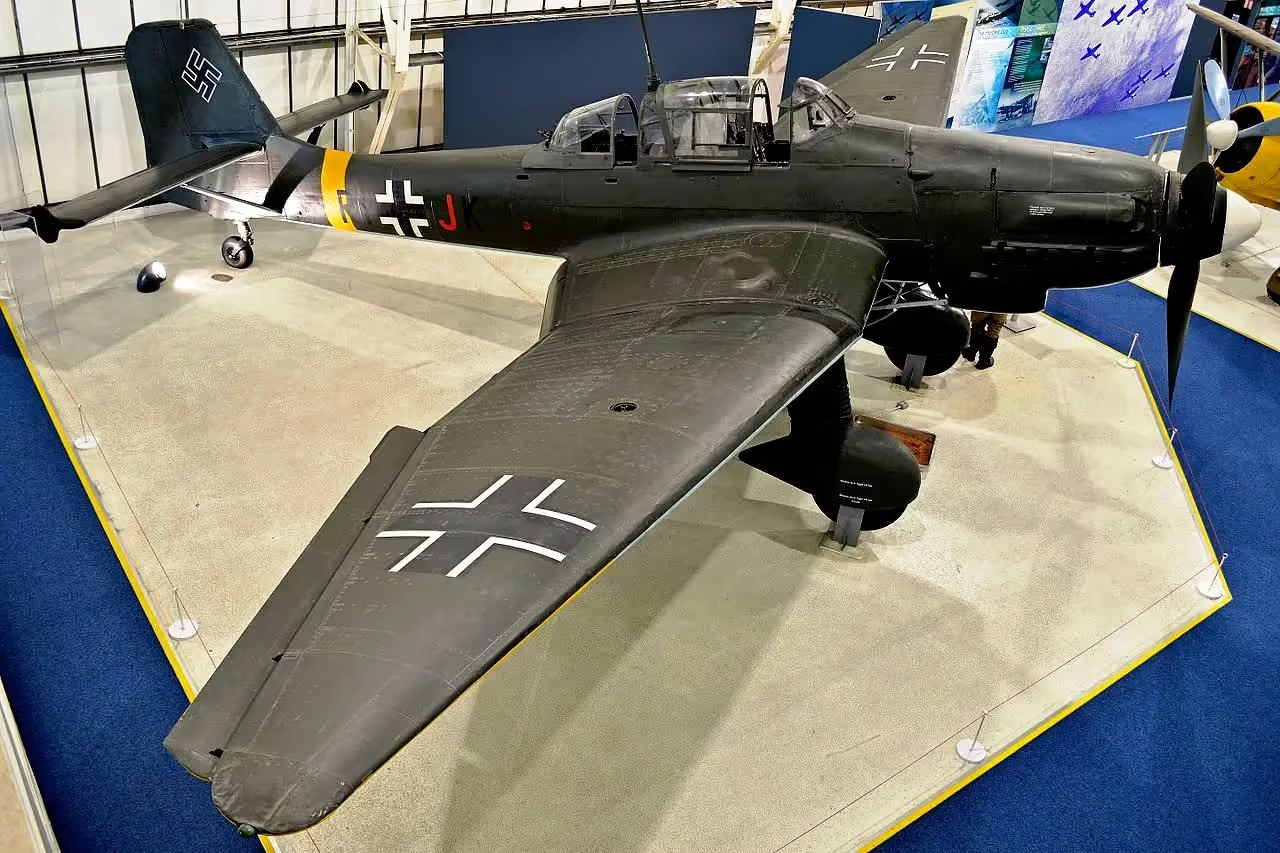

(Alan Wilson Photos)
Junkers Ju 87G-2 Stuka, (Wk. Nr. 494083). This aircraft was captured at Eggebek in Schleswig-Hostein, Germany in May 1945. No Air Ministry number was allocated. Royal Air Force Museum Cosford, Shifnal, Shropshire.
The Junkers Ju 87 Stuka, dive-bomber displayed at the Royal Air Force Museum was captured by British troops in Germany in 1945 It is thought to have been built in 1943–1944 as a D-5 before being rebuilt as a G-2 variant, possibly by fitting G-2 outer wings to a D-5 airframe. After the war, it was one of 12 captured German aircraft selected by the British for museum preservation. In 1967, permission was given to use the aircraft in the film Battle of Britain and it was repainted and modified to resemble a 1940 variant of the Ju 87. The engine was found to be in excellent condition and there was little difficulty in starting it, but returning the aircraft to airworthiness was considered too costly for the filmmakers, and ultimately, models were used in the film to represent Stukas. In 1998, the film modifications were removed, and the aircraft returned to the original G-2 configuration. This aircraft has also been reported as being Junkers Ju 87B, (Wk. Nr. 5763), RAF HK827.

(IWM Photo HU 108219)
Junkers Ju 88R-1 D5+EV of IV/NJG 3 fitted with FuG 202 AI radar. The crew of this aircraft defected from Norway to Britain in May 1943, landing at Dyce in Scotland, and delivering their aircraft and its hitherto secret radar into the hands of the RAF. The photo shows the aircraft post-war, after a period of restoration.

(Roland Turner Photo)



(Hugh Llewlyn Photos)




(Alan Wilson Photo)
Junkers Ju 88R-1, (Wk. Nr. 360043), D5+EV from IV./NJG3. Originally built as a Ju 88A-1 bomber in 1942, it was converted to R-1 standard early in 1943 for the night fighter role. In May 1943, a three-man crew was ordered to intercept an unarmed BOAC Mosquito courier flight from Leuchars, Scotland flying to Stockholm, Sweden. Two hours after their take-off, the aircrew of this aircraft defected to England, sending a fake message to their home base that they had a fire in the starboard engine. The bomber descended to sea level and dropped three life rafts to make the search parties think the aircraft had ditched at sea. The crew then few on to Scotland. The aircraft was a significant acquisition for the RAF as this aircraft was fitted with the most up to date FuG 202 Lichtenstein B/C radar installation. This aircraft was designated RAF PJ876 and underwent trials with the RAF Wireless and Electrical Flight section of No. 1426 (Enemy Aircraft) Flight. It was acquired by the RAF Museum in 1978. The antenna of the on this aircraft are replicas, as the entire radar system was removed from the aircraft for evaluation during the war. It had been preserved in the Royal Air Force Museum Hendon, London, but is currently located at the Royal Air Force Museum Cosford, Shifnal, Shropshire, while the Hendon location is being upgraded.

(TSRL Photo)
Klemm Kl.35D, Reg. No. G-KLEM, The Shuttleworth Collection, Old Warden, Bedfordshire.
Messerschmitt Bf 109 E-1 (Wk. Nr. unknown), ex-Spanish Air Force (Serial No. C4E-88), Robs Lamplough, Hungerford.
Messerschmitt Bf 109 E-1 (Wk. Nr. 854), Charleston Aviation Services.

(Alan Wilson Photo)

(Roland Turner Photo)
Messerschmitt Bf 109E-3 (Wk. Nr. 1190), ex-Bf109E-4/N, ex-4./JG 26, "White 4", Imperial War Museum, Duxford, Cambridgeshire.
Messerschmitt Bf 109 E-3 (Wk. Nr. 1983), ex-5./JG 5 "Red ?", Charleston Aviation Services, Colchester.
Messerschmitt Bf 109 E-3 (Wk. Nr. 3523), ex-CS + AJ, ex-Bf 109E-7, ex-5/JG 5 "Red 6", Jim Pearce, Sussex.


(Author Photos)
Messerschmitt Bf 109 E-3 (Wk. Nr. 3579), ex-JG 2, ex-Bf 109E-7, 4/JG, "White 14", crashed 2 August 1942. White 14 was built in 1939 and fought in the Battle of Britain. It was flown by Luftwaffe ace Hans-Joachim Marseille, who had 158 kills. Previously oOwned by the Russell Group in Canada, Reg. No. CF-EML, it was sold to a British buyer and is now based in England, Reg. No. G-CIPB, Biggin Hill Heritage Hangar, Biggin Hill. Airworthy, first flown after reassembly 13 June 2017.
Messerschmitt Bf 109 E-3 (Wk. Nr. 4034), ex-1/JG 77, "Black 5", ex-8/JG 53, "Black 6", force-landed due to an apparent engine failure cose to Lower Hardres, near Canterbury, Kent, on 2 Nov 1940. Reg. No. G-CDTI, Rare Aero Ltd, Jersey. Built by Focke-Wulf in Bremen in 1939. Restoration is proceeding.


(RAF Photos)
Messerschmitt Bf 109E-3, (Wk. Nr. 4101), "Black 12" from I./JG51, RAF DG200, in flight while serving with No. 1426 (Enemy Aircraft) Flight. This aircraft force-landed at Manston, Kent, on 27 November 1940, after being attacked by Supermarine Spitfires of No. 66 Squadron RAF over the Thames estuary. After repair at the Royal Aircraft Establishment it was delivered to Rolls-Royce Ltd at Hucknall in February 1941 for engine performance tests. On 8 February 1942 it was passed to the Controller of Research and Development at Hatfield for propeller tests before going on to the Aircraft and Armament Experimental Establishment at Boscombe Down, and, in March 1942, to No. 1426 Flight at Duxford and later Collyweston. In 1943, DG200 was put into storage, eventually moving to St Athan in 1969 for refurbishment. Once restored to its wartime paint scheme, it moved to the Royal Air Force Museum Hendon, London, in 1976, where it is presently on display in the Battle of Britain Hall. DG200 is seen here being flown without its cockpit canopy, which was removed (and never replaced) while the aircraft was at Hucknall to enable Wing Commander J.H. Heyworth, a Rolls Royce test pilot who was very tall, to fit into the cockpit. This aircraft is now on display in the Royal Air Force Museum Hendon, London.
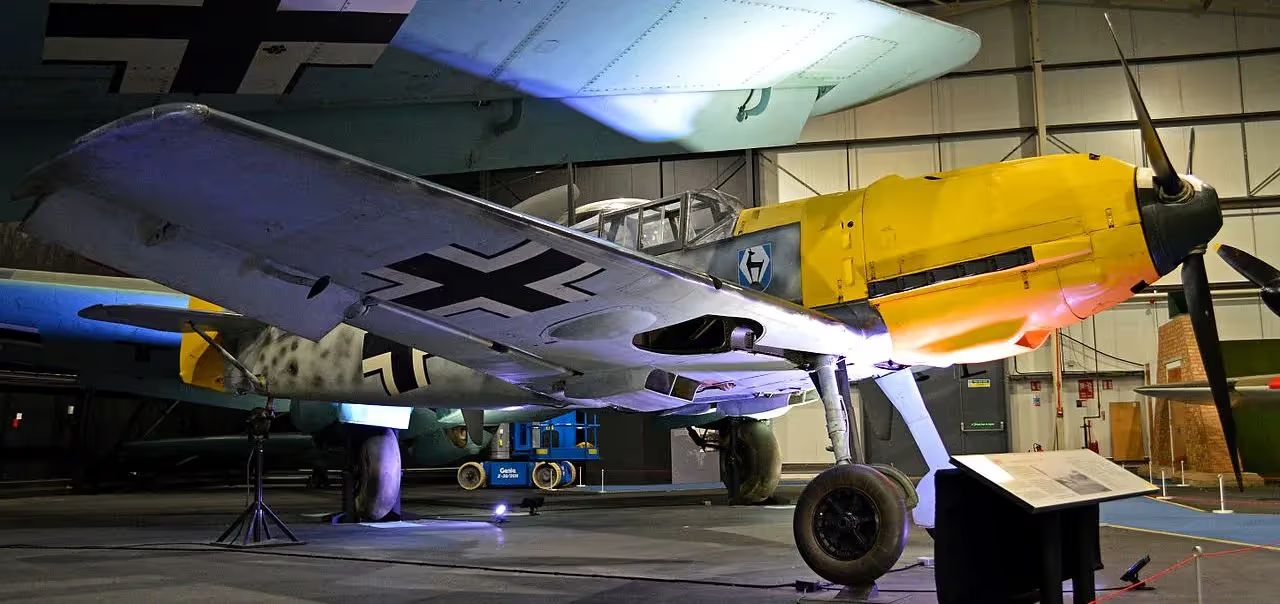


(Alan Wilson Photos)

(Mike Freer - Touchdown-aviation Photo)
Messerschmitt Bf 109E-3 (Wk. Nr. 4101), ex-GH + DX, ex-6./JG 52, "Yellow 8", ex-2/JG51, "Black 12", ex-RAF DG200, ex-No. 1426 Flight RAF (the "Rafwaffe"), used in Battle of Britain film, Royal Air Force Museum Hendon, London.
Messerschmitt Bf 109 E-4 (Wk. Nr. 4853), ex-2./JG 51, wreck on display at the Kent Battle of Britain Museum, Hawkinge.
Messerschmitt Bf 109F-4 (Wk. Nr. 7485), ex-9./JG 5, "Black 1", Charleston Aviation Services, Colchester, Essex.
Messerschmitt Bf 109F-4 (Wk. Nr. 8347), ex-6./JG 54, "Yellow 10", Charleston Aviation Services, Colchester, Essex.
Messerschmitt Bf 109G-6 (Wk. Nr. 15458), ex-8./JG 1 "Black 10", ex-III/JG 1, CW Tomkins Ltd, UK.


(Mike Freer - Touchdown-aviation Photos)

(Alan Wilson Photo)

(Roland Turner Photo)

(Les Chatfield Photo)


(Oren Rozen Photos)
Messerschmitt Bf 109G-2 trop (Wk. Nr. 10639), ex-PG + QJ, ex-III./JG 77, "Black 6", ex-3 Sdn RAAF, "CV-V", ex-RAF RN228, No.1426 Flight (Enemy Aircraft), Reg. No. G-USTV, Royal Air Force Museum Cosford, Shifnal, Shropshire.
Hispano Aviación HA-1112-M1L Buchón, (Serial No. C.4K-105), c/n 145, "White 9", Reg. No. G-AWHH, N6036, movie: movie: Battle of Britain, Anglia Aircraft Restorations, Sywell, Duxford. Airworthy.
Hispano Aviación HA-1112-M1L Buchón, (Serial No. C.4K-152), c/n 220, Reg. No. G-AWHR, Reg. No. N4109G, Air Leasing. Airworthy.
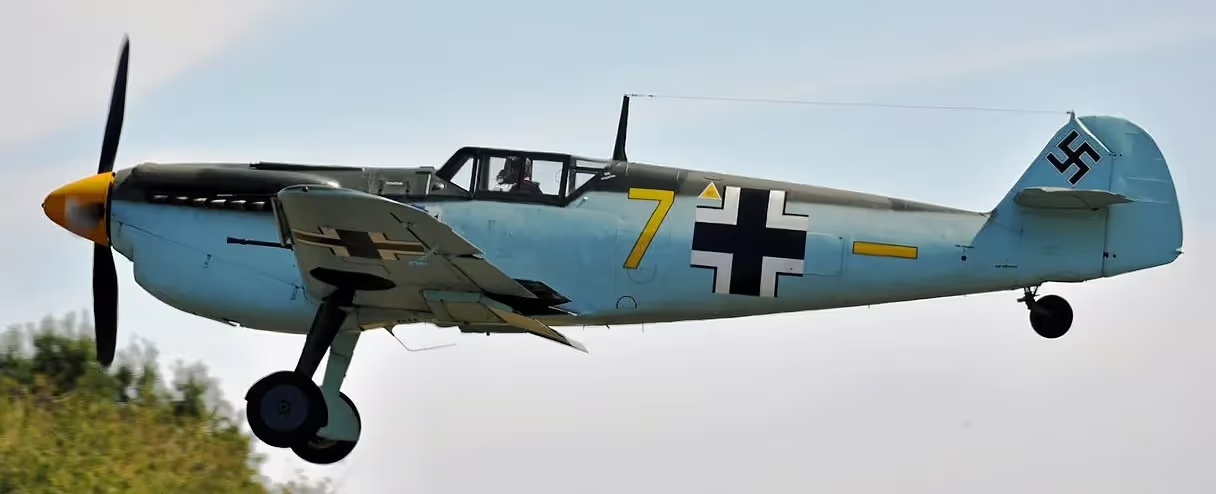
(Eric Salard Photo)
Hispano Aviación HA-1112-M1L Buchón, (Serial No. C.4K-99), c/n 187, "Yellow 7", Reg. No. G-AWHM, N90604.


(Alan Wilson Photo)
Hispano Aviación HA-1112-M1L Buchón, (Serial No. C.4K-31), c/n 67, "Black 1", Reg. No. G-AWHE, movie: Battle of Britain, "Red 8", "Yellow 14", Air Leasing, Sywell. Airworthy.


(AlanWilson Photos)

(Mark Harkin Photo)
Hispano Aviación HA-1112-M1L Buchón, (Serial No. C.4K-102), c/n 172. Previously "Red 1", painted as "Yellow 10", Reg. No. G-BWUE. This Buchón was built in Spain post-war. Restored in original condition and still fitted with a Rolls-Royce Merlin engine, which is how they were built. Painted in the colours it wore when involved in the production of 'The Battle of Britain' film, at Duxford in 1968, when it was registered as G-AWHK. It is operated by ARCo. Spitfire Ltd, Duxford, Cambridgeshire.
Hispano Aviación HA-1112-M1L Buchón, (Serial No. C.4K-111), c/n 184. G-HISP.
Hispano Aviación HA-1112-M1L Buchón, (Serial No. C.4K-30), c/n 52, coded 471-26, used for airframe repair instruction, used for spares.

(Alan Wilson Photo)
Hispano Aviación HA-1112-M1L Buchón previously "Yellow 10", Reg. No. G-AWHK, painted Black 2 for the film "Dunkirk".

(Alan Wilson Photo)
Hispano Aviación HA-1112-M1L Buchón, previously "Yellow 10", Reg. No. G-AWHK, recently repainted in a weathered desert paint scheme, to represent Messerschmitt Bf109 E-7, “Black 8″ flown by Leutnant Werner Schroer of Jagdgeschwader JG-27 in April 1941. Historic Flying Ltd, Duxford, Cambridgeshire.
Hispano Aviación HA-1112-M1L Buchón, Reg. No. N109ME, Privately owned, Duxford, Cambridgeshire.

(Mike Freer - Touchdown-aviation Photo)
Hispano Aviación HA-1112-M1L Buchón, "Black 3", Reg. No. G-BOML, at Duxford, Cambridgeshire, on 10 July 1999. This aircraft was lost in a crash at Barcelona, Spain on 25 Sep 1999.

(Anthony Noble Photo)
Hispano Aviación HA-1112-M1L Buchón, c/n 235, "Red 14", ex-G-HUNN, now in the USA as Reg. No. N109GU.

(Steve Lynes Photo)
Hispano Aviación HA-1112-M4L Buchón, (Serial No. C.4K-112), c/n 40/2, two-seater dual control variant, painted as "Red 11" as flown during the film "Battle of Britain" in 1968, Reg. No. G-AWHC, N1109G. Air Leasing, Sywell. Airworthy.

(RAF Photo)
Messerschmitt Bf 110, (Wk. Nr. 3869), remains from the wreck of the Flight of Rudolf Hess To Britain 1941, H955. A British officer inspects the wreckage of Hess' Messerchmitt Bf 110 after it had been removed to an RAF depot, Scotland, 13 May 1941.

(Alan Wilson Photo)
Messerschmitt Bf 110, (Wk. Nr. 3869), coded VJ+OQ, remains of the fusleage of the aircraft flown byHitler's deputy, Rudolf Hess, who flew solo to Scotland from Bavaria on the the night of 10 May 1941, apparently in a secret and surprise attempt to negotiate peace. The remains are currently on display within the IWM Duxford's Air and Space Hangar in the UK.


Messerschmitt Bf 110G-4/R6, (Wk. Nr. 730301) with FuG220 radar, captured at Grove, Denmark. Designated RAF AM34, this aircraft is preserved in the RAF Museum, Hendon. (RAF Photos)

(John Parr Photo)

(Calgaco Photo)


(Kogo Photos)
Messerschmitt Bf 110G-4/R6, (Wk. Nr. 730301) with FuG220 radar, captured at Grove, Denmark in May 1945. Designated RAF AM34, this aircraft is displayed in the RAF Museum, Hendon.

(Dapi89 Photo)


(Clemens Vasters Photos)

(Rept0n1x Photo)
Messerschmitt Me 163B-1a Komet, (Wk. Nr. 191614), captured at Husum. Designated RAF AM207. This aircraft last flew on 22 April 1945, when it shot down an RAF Lancaster. It is currently painted as (Wk. Nr. 191461). Royal Air Force Museum Cosford, Shifnal, Shropshire.

(Ronnie Macdonald Photo)

(Ad Meskens Photo)

(Guinog Photo)
Messerschmitt Me 163B-1a Komet, (Wk. Nr. 191659), "Yellow 15". Designated RAF AM215. Captured at Husum, Schleswig Holstein at the end of the war, this Komet went to the College of Aeronautics at Cranfield in 1947. In 1976 it was refurbished and loaned to the Royal Scottish Museum. In 2007 it was donated to the museum by Cranfield University. National Museum of Flight in East Fortune, East Lothian, Scotland.

(Alan Wilson Photo)
Messerschmitt Me 163B-1a Komet, (Wk. Nr. 191316), "Yellow 6", Science Museum, South Kensington, London.


(Alan Wilson Photos)

(Aldo Bidini Photo)
Messerschmitt Me 262A-1a Schwalbe, (Wk. Nr. 112372), "Red 2", captured at Schleswig. Designated RAF AM51, later VK893. AM51 was test flown by the Royal Aircraft Establishment Aerodynamics Flight. It was painted "Yellow 7", and is now painted as "Yellow 4". It was on display in the Royal Air Force Museum Hendon, London for many years, before being moved to the Royal Air Force Museum Cosford, Shifnal, Shropshire.




(RAF Photos)

(IWM Photo CH 15616)
Messerschmitt Me 410A-3 (Wk. Nr. 10259) being examined by RAF mechanics at No. 1426 (Enemy Aircraft) Flight at Collyweston, Northamptonshire (UK). This aircraft was formerly F6+OK of 2(F)./122. The crew, Fw. Hans Beyer and Uffz. Helmut Hein, got lost on the return leg to Perugia and landed by mistake at Monte Corvino, Italy, on 27 November 1943. Designated RAF (Serial TF209), it arrived for testing at the Royal Aircraft Establishment, Farnborough, on 14 April 1944, and was also evaluated by the Aeroplane and Armament Experimental Establishment, Boscombe Down. TF209 flew with the Fighter Interception Unit at Wittering from August 1944 until March 1946 when it was transferred to No. 6 Maintenance Unit at Brize Norton.

(RAF Photo)

(Mike Freer - Touchdown-aviation Photo)


(Clemens Vasters Photos)

(Tony Hisgett Photo)

(Dapi99 Photo)

(ozz13x Photo)

(Allen Watkin Photo)
Messerschmitt Me 410A-1/U2 Hornisse, (Wk. Nr. 420430), captured at Vaerlose. Designated RAF AM72. Royal Air Force Museum Cosford, Shifnal, Shropshire.
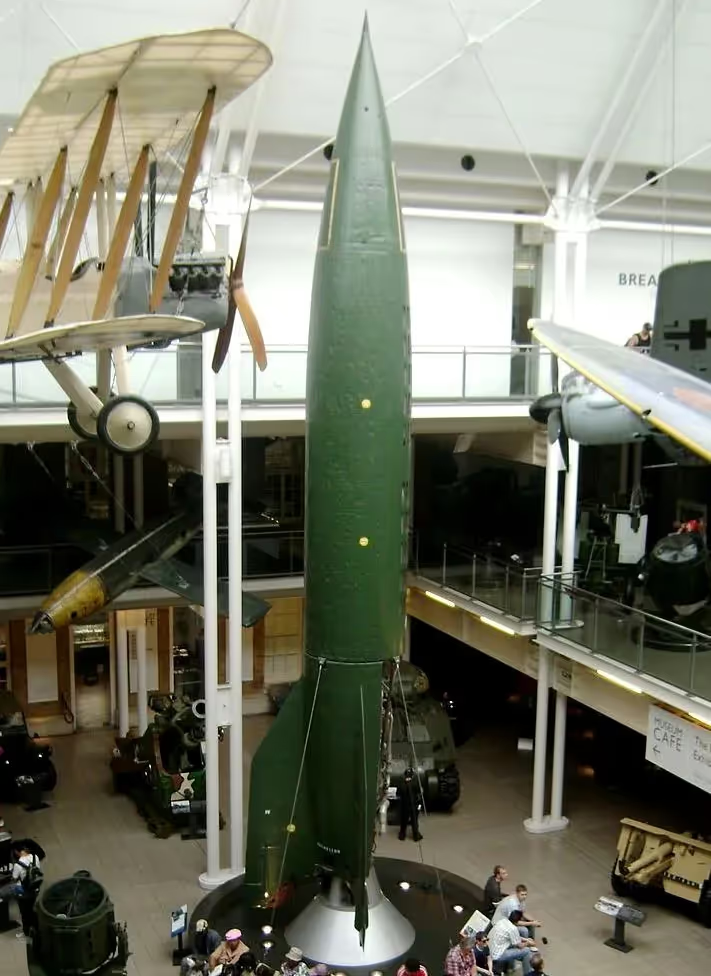
(Zzztriple2000 Photo)

(Joseolgon Photo)
V2 rocket on display at the Imperial War Museum, London.

(Hugh Llewelyn Photo)
V2 rocket on display in the RAF Museum, Hendon, England.

(Rept0n1x Photo)
V2 rocket on display in RAF Museum Cosford, Shropshire, England.

(Goshimini Photo)

(Rept0n1x Photo)

(Allen Watkin Photo)
V2 Rocket, Royal Air Force Museum Cosford, Shifnal, Shropshire.





